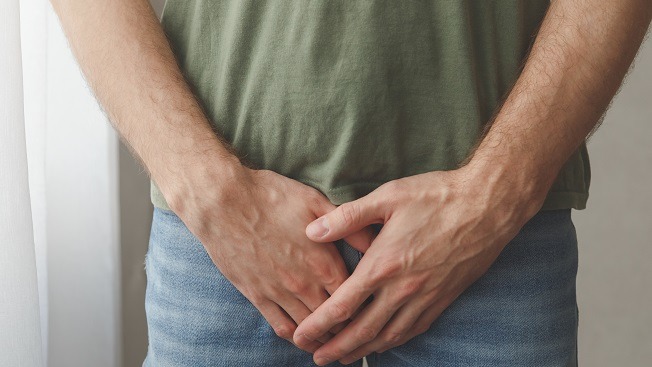Any man (or boy) will tell you, trauma to the testicles is a pain they never forget. Unfortunately, testicular trauma can happen fairly easy thanks to the location of this male reproductive organ. Since the scrotum, located outside the body, is the sac holding and housing the testicles, there is very little protection for this organ with multiple nerve endings contributing to its potential for severe pain sensitivity. On top of that, without any muscles or bones offering some safeguarding, the testicles are susceptible to significant trauma if hit, kicked, or crushed.
Purpose of the testicles
The oval-shaped testicles, or male gonads, reside within the scrotum, which hangs below the penis. Each testes is the size of a very large olive weighing about 0.35 to 0.5 ounces and typically 2 inches in length. The testicles are the primary male reproductive organs, and they have a very important job of producing gametes, or sperm, and secreting hormones, primarily testosterone. Each testes contains coiled masses of tubes called seminiferous tubules, which are responsible for producing sperm cells by a process called spermatogenesis. To keep the testes from bouncing around in the scrotal sac, each testicle is secured by a structure called the spermatic cord.
When testicular trauma occurs
If a man’s testicles have major trauma forced upon them, an evaluation by a physician for proper treatment is strongly advised. Depending on the extent of the force of trauma to the testicles will determine the extent of damage to them. Developing an infection is a primary concern of trauma to the testicles.
As stated earlier, any male will know immediately of trauma to their testicles. Severe pain will be their first indication that some sort of injury has been inflicted. If the trauma is relatively minor, albeit painful, most men likely will not need to seek medical care. But, if the injury goes beyond a minor trauma, then it is imperative men seek medical care. Here are examples if a man requires medical intervention:
- Bruising or swelling of the scrotum
- Difficulty urinating or having blood in the urine
- Running a fever after a testicular injury
Diagnosing the extent of damage after testicular trauma
Since there is the risk of permanent damage of trauma to the testicles, it’s important for men to seek medical evaluation and advice from a urologist for the best care. Without treatment for a serious injury, this could result in infertility or loss of the testicle(s).
There is also the possibility that without medical treatment for testicular trauma, it could lead to these possible complications:
- Testicular rupture: This may happen if there is direct blunt trauma to the scrotum and involves a rip or tear to the tunica albuginea that damages the testicles.
- Testicular torsion: This injury involves a “twisting of the testes” that usually occurs suddenly with severe pain, enlargement of the affected testicle, tenderness, and swelling. Within the scrotum, the testicles are secured at one end by a structure called the spermatic cord. Sometimes, this cord gets twisted cutting off the testicle’s blood supply. Because the spermatic cord has rotated and is cutting off blood flow to the testicle(s), eventually the testes will have significant damage without sufficient blood flow.
- Epididymitis: Epididymitis is an inflammation involving the epididymis, a long, narrow tube tightly coiled at the back of the testicles which store and carry sperm. This condition is most often caused by a bacterial infection including sexually transmitted infections such as gonorrhea or chlamydia. Sometimes trauma to the groin can result in epididymitis or when a man does heavy lifting causing urine to flow backward into the epididymis.
A urologist will do a physical exam along with questioning how the trauma occurred to assess the extent of the injury. By physically examining the exterior and interior of the scrotum, a urologist can check to see if there are any internal injuries to the epididymis or vas deferens. If they determine there are no major injuries, the best course of action will be to recommend support for the scrotum by wearing a jock strap and to prescribe medication such as ibuprofen or acetaminophen for pain control.
If the urologist needs further help with determining the extent of trauma to the testicles, they will order an ultrasound scan of the scrotum. An ultrasound scan will provide important images of not only the scrotum but also of the testicle, epididymis and spermatic cord for evaluation of any injury. A magnetic resonance imaging (MRI) scan may also be ordered if the urologist needs more information.
Treating testicular trauma
Treatment will be based on the type and extent of the injury or trauma to the testicles. This may include anti-inflammatory and/or antibiotic medications, wearing a jock strap, surgery, or if the injury is significant, removal of the testicle. Keep in mind that in order to father a child, only one working testicle is needed for fertility.
The best advice is to be on guard for protecting this area of the body, especially when playing sports when testicular injuries are more likely to occur. Seek immediate treatment with a urologist if the trauma has significant symptoms associated with it. The sooner this type of injury is evaluated and treated properly, the greater chance of a full recovery.


